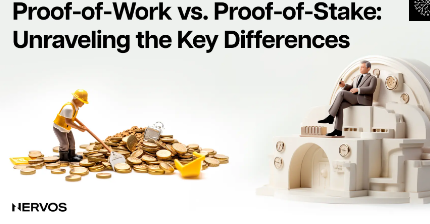From Proof of Work to Proof of Stake: Understanding Consensus Mechanisms
Introduction: The Importance of Consensus Mechanisms in Blockchain
Blockchain technology relies on a consensus mechanism to validate transactions and maintain the integrity of the distributed ledger. Consensus mechanisms are essential in ensuring that all participants in a blockchain network agree on the current state of the blockchain, even in the absence of a central authority. In the early days of cryptocurrency, Proof of Work (PoW) was the dominant consensus mechanism, but the growing need for energy efficiency and scalability has led to the rise of Proof of Stake (PoS) and other alternatives.
In this article, we will dive into the two most widely discussed consensus mechanisms—Proof of Work and Proof of Stake. We will explore their differences, advantages, disadvantages, and the future of consensus mechanisms in cryptocurrency development.
1. Proof of Work (PoW): The Origin of Blockchain Consensus
Proof of Work (PoW) is the original consensus mechanism that powers Bitcoin, the first decentralized cryptocurrency. PoW requires participants (also known as miners) to solve complex mathematical puzzles in order to validate transactions and add them to the blockchain. This process is resource-intensive, as miners must use significant computational power to perform these calculations.
How Proof of Work Works:
- Mining: Miners compete to solve complex mathematical problems, and the first miner to find the solution is rewarded with newly minted cryptocurrency and the right to add a new block to the blockchain.
- Security: The process of solving these puzzles requires a large amount of computational power, making it difficult for malicious actors to take control of the network. As more miners join the network, the security of the blockchain increases.
- Decentralization: PoW encourages decentralization by allowing anyone with the necessary hardware and electricity to participate in the mining process, regardless of their location.
Advantages of Proof of Work:
- Proven Security: PoW has a long track record of securing blockchain networks, particularly Bitcoin, which has never been successfully attacked or compromised.
- Decentralization: Since anyone with computing power can participate in mining, PoW supports a high degree of decentralization, reducing the risk of centralization or control by a single entity.
- Strong Network Effect: As the most widely used consensus mechanism, PoW has a large and well-established network of miners, making it more resistant to attacks.
Disadvantages of Proof of Work:
- High Energy Consumption: The computational power required for mining consumes vast amounts of electricity, making PoW energy-intensive and environmentally unfriendly.
- Scalability Issues: PoW can struggle with scalability, as the increasing number of transactions and the need for more mining power can lead to congestion and high transaction fees.
- Centralization of Mining: While PoW theoretically supports decentralization, the high cost of mining equipment and electricity has led to mining pools and large corporations controlling much of the mining power, reducing decentralization in practice.
2. Proof of Stake (PoS): A More Energy-Efficient Alternative
Proof of Stake (PoS) is an alternative consensus mechanism that aims to address some of the inefficiencies and environmental concerns associated with PoW. In PoS, validators (instead of miners) are selected to create new blocks and validate transactions based on the amount of cryptocurrency they hold and are willing to “stake” as collateral. The more cryptocurrency a validator stakes, the higher their chances of being chosen to validate a block.
How Proof of Stake Works:
- Staking: Validators lock up a certain amount of their cryptocurrency as collateral (or “stake”). Validators are then selected to validate blocks based on the amount of cryptocurrency they have staked.
- Validation: When a validator is selected, they verify transactions, create new blocks, and add them to the blockchain. In return for this work, they are rewarded with transaction fees or newly minted cryptocurrency.
- Security: If a validator behaves maliciously, such as by attempting to add invalid transactions, they risk losing their staked cryptocurrency. This provides an incentive for validators to act honestly and follow the rules.
Advantages of Proof of Stake:
- Energy Efficiency: PoS is far more energy-efficient than PoW because it does not require extensive computational power for validation. Validators are chosen based on their stake, not on their ability to solve complex puzzles.
- Scalability: PoS can offer better scalability than PoW, as the process of validating transactions does not require massive computational resources. This can help reduce transaction fees and improve network throughput.
- Reduced Centralization Risk: In PoS, validators are selected based on their stake, and the system is designed to prevent any single entity from accumulating too much control over the network. This helps mitigate the risk of centralization seen in PoW mining pools.
Disadvantages of Proof of Stake:
- Initial Distribution of Coins: PoS systems can favor early adopters who have a large amount of cryptocurrency, as their stake gives them a higher chance of being selected as validators. This could lead to wealth concentration in the network.
- Less Proven Security: While PoS has been proven to be secure in some blockchain networks (like Ethereum 2.0), it is still relatively new compared to PoW. Some critics argue that PoS may be more susceptible to certain types of attacks, such as “nothing at stake” attacks or long-range attacks.
- Validator Collusion Risk: Validators in PoS systems may collude to manipulate the network or take advantage of weaknesses in the consensus protocol.
3. Hybrid Consensus Mechanisms: Combining PoW and PoS
Some blockchain networks have adopted hybrid consensus mechanisms that combine the benefits of both PoW and PoS. These hybrid models aim to balance the security and decentralization of PoW with the energy efficiency and scalability of PoS.
Examples of Hybrid Consensus Mechanisms:
- Decred: Decred combines PoW and PoS to provide a hybrid approach to consensus. In Decred, miners use PoW to create blocks, but validators using PoS have the ability to vote on changes to the protocol and approve blocks. This hybrid system ensures decentralization and security while addressing some of the issues with pure PoS and PoW.
- Ethereum 2.0: Ethereum is transitioning from PoW to PoS through its Ethereum 2.0 upgrade. The goal is to create a more scalable, secure, and energy-efficient network by combining PoS with other mechanisms, such as sharding, to improve transaction throughput.
4. The Future of Consensus Mechanisms
The future of consensus mechanisms in blockchain development is rapidly evolving. While PoW and PoS are the two dominant models, new consensus mechanisms are emerging to address specific challenges, such as scalability, security, and decentralization.
Promising Alternatives:
- Delegated Proof of Stake (DPoS): DPoS is an evolution of PoS where stakeholders vote for a small number of trusted delegates who validate transactions and produce blocks. DPoS aims to increase scalability and efficiency while maintaining decentralization.
- Proof of Authority (PoA): In PoA, validators are pre-approved entities that have a reputation or authority to validate transactions. This mechanism is typically used in private or permissioned blockchains, where speed and efficiency are more important than decentralization.
- Proof of Space (PoSpace): PoSpace, also known as Proof of Capacity, uses storage space rather than computational power or staked tokens as the resource to validate transactions. This approach aims to reduce the environmental impact of mining while maintaining decentralization.
5. Conclusion: Choosing the Right Consensus Mechanism
The choice of consensus mechanism is one of the most important decisions in the development of a blockchain project. Proof of Work and Proof of Stake offer distinct advantages and challenges, with PoW providing a proven, secure system at the cost of energy efficiency, and PoS offering a more environmentally friendly alternative but facing some security concerns.
As the cryptocurrency and blockchain landscape continues to evolve, developers will need to carefully evaluate the trade-offs of each consensus mechanism based on the goals of their project, the target audience, and the desired outcomes. The future of blockchain development is likely to see more hybrid models and innovative consensus algorithms, which will continue to shape the scalability, security, and decentralization of the blockchain ecosystem.

Also Read :
